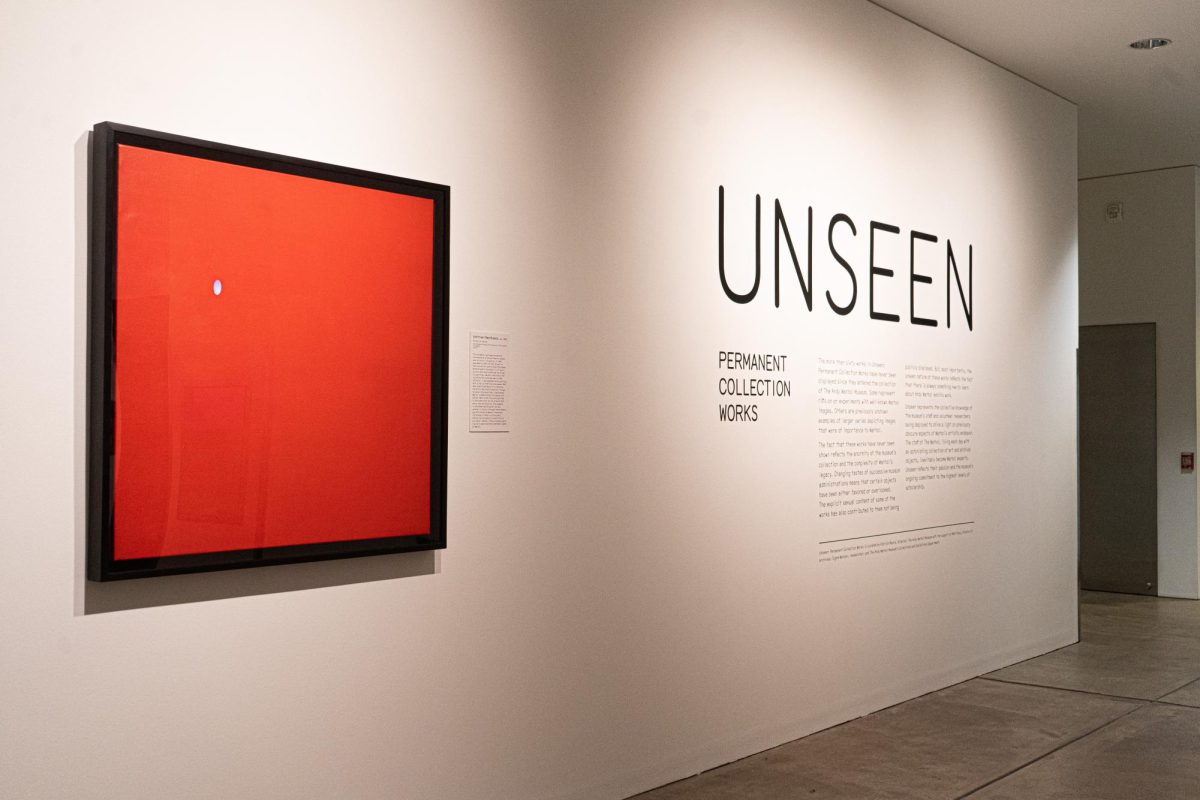Andy Warhol’s works ponder questions of mundanity, sexuality and icons, with images of Marilyn Monroe and Campbell soup cans found throughout the five floors of the Andy Warhol Museum on the North Side. One exhibit at the museum digs through the archives to highlight feelings that come with being an artist — passion, love and human desire.
“Unseen: Permanent Collection Works” is the Andy Warhol Museum’s most recent temporary exhibit. Running from Nov. 2, 2023, until March 4, 2024, the display shows off about 60 works found within the collection of the museums, most of which have never seen the strikingly warm light of the gallery. While some of the works seem to go with Warhol’s classic style, others step away from the artist’s usual genre of pop art.
The exhibition consists of various series, such as “Distorted Portraits,” where Warhol photographs clients and models with extreme contrast to create black and white images; the series “Ladies and Gentlemen,” made through mixed medium focusing on transgender people living in the streets; works from the 1980s that showcase Warhol’s work in advertising and two explicit works called “Torso” and “Sex Parts.”
Andy Warhol — born Andrew Warhola Jr. — is one of Pittsburgh’s most famous names. Born and raised in Oakland to Slovak parents, Warhol’s art would take him to New York City, where he became a leader in the pop art movement. His studio, The Factory, became the epicenter for the queer and artistic communities of New York City, where artists Jean-Michel Basquiat, Mick Jagger, Keith Haring, David Bowie and more would become “Superstars,” the status granted to regulars at the studio.
The exhibition gave the museum’s staff and visitors a better sense of what made Warhol an ever-changing presence in the art world. Patrick Moore, director of the Andy Warhol Museum and curator for “Unseen,” said Warhol’s world and practice were very diverse.
“We realized as a staff that even though we knew the museum’s collection very well, that occasionally there were objects we had never seen before and wanted to know more about them,” Moore said.
Finding new ways to depict an already established artist was the key to the exhibition. Matt Gray, director of archives at the museum and a collaborator for the exhibition, said the archives had enough material to work with.
“The Archives at The Andy Warhol Museum contains approximately 500,000 individual objects collected by Warhol over the course of his life. As interest in Warhol grows, so does the need for new ideas about his life and work,” Gray said.
With the 500,000 individual works in the archives, the research never truly ends. Aaron Levi Garvey, chief curator of the Andy Warhol Museum, explained how the public helped the museum shape the exhibition.
“One piece within the show was previously unidentified, and by putting it on view in the exhibition, we were able to identify the subject through the help of a visitor to the museum who know[s] the subject personally,” Levi Garvey said on a tour of the exhibit.
Warhol transformed the mundane into iconic and famous, but the focal point of the exhibition was his most personal works. On a small section of the exhibition, hidden behind a wall for content warning, visitors see “Sex Parts” and “Torso.” Levi Garvey said these works were scandalous in their time and came from the private collections of Warhol’s clients.
“They were sold to clients privately, or made for friends of friends,” Levi Garvey said.
“‘Sex Parts’ consists of seven black-and-white screen prints focused on the silhouette of the naked clients and friend’s figures. The works are completely different from Andy Warhol’s classic style, more textured and more rugged. They evoke his work as a filmmaker as if the works are film stills. These works, as well as being private for the client, were not exhibited due to their very sexual content. Yet they showcase Andy Warhol’s exploration of identity and sexuality. Even if closeted, art allowed him to explore the human body. At the end of the day, Warhol was a human who also wanted mundane things.”
The museum is always searching for ways to showcase the range of Warhol. The exhibition provided an opportunity to emphasize the artist’s enduring legacy. Moore said unveiling unseen work allows the public to understand the artist better.
“[They show] that Warhol was so much more than his social life and the signature works like Liz and Marilyn for which he is known,” Moore said.
A previous version of this story stated that Warhol’s parents were Austrian rather than Slovak. The Pitt News regrets this error.


